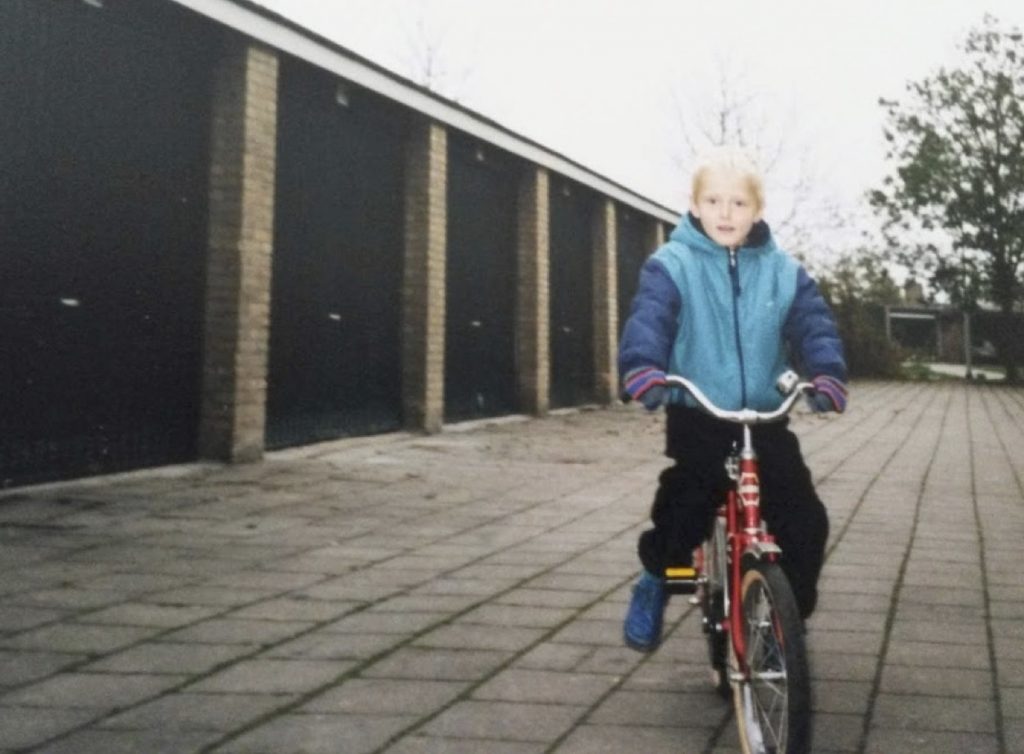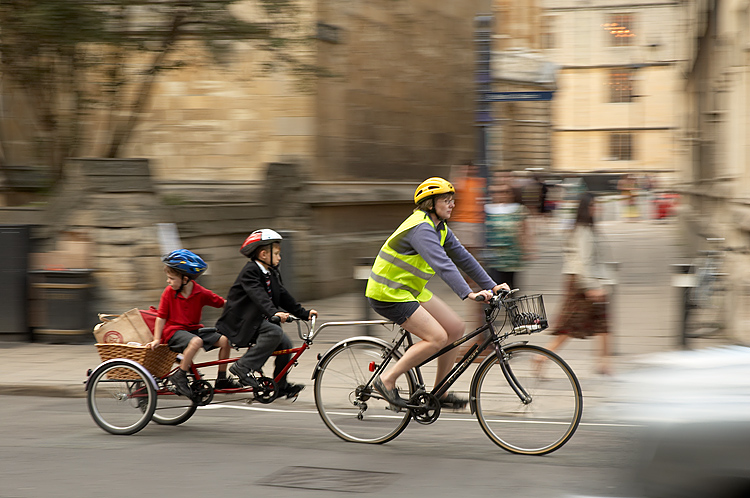By Theo Klimstra
Image by Kamyar Adl, CC BY 2.0, via Wikimedia Commons
Editor’s Note:
Biking rarely makes its way into conversations about children’s development as earth stewards – but it should. To be free to bike is to be free to connect to wind and weather and to get to areas that may be wild or at least green. And so, we should learn from today’s biking cultures – as Theo Klimstra’s story growing up in the Netherlands so clearly demonstrates.
One of the striking differences between the Netherlands and most countries is the vast number of bikes that you’ll see everywhere. In the Netherlands, everybody rides bikes, partly because they are cheap to buy and cheap to maintain for commuting (no gas required) and partly because Dutch employers team up with the tax service to allow employees to get a full refund on their new bike. Furthermore, parents bring their children (yes, multiple children, sometimes as many as four or five on a single bike!) to school or daycare; others bring TVs and small pieces of furniture home on bikes while dodging wandering tourists in the busy streets of Amsterdam, and if you visit The Hague, you might see the prime minister himself biking to work. Even taking your rusty old bike to a job interview is considered completely normal. All this is to say that, in the Netherlands, riding a bike is not just something that kids do; it is something almost everyone does – making the Netherlands a true biking culture. Why is this so? And was it always like this?
For one thing, the Netherlands is a perfect place to bike. There are almost no hills. Then there are the relatively short distances between towns and cities. And the distance from the outer suburbs to a city center typically is no more than six miles. On top of that, there’s an extensive network of bike paths where bikes neither share with cars nor with pedestrians. These bike paths have been there since the 1950s and 1960s, when the roads in the densely populated Netherlands got more and more busy, and when cars spent more time standing still than they did moving. Given the logjam on highways, governments decided to give more space to bikes and less space to cars. Yes, this initially made a lot of Dutch people very angry… but now, people are happy with the change, myself included. When I lived and worked in Utrecht, my three-mile commute during rush hour would have taken up to 40 minutes in a car while the same commute took me only a 20-minute bike ride!
By the 1980’s and 1990’s, when I was growing up, the bike paths were already there — paving the way, so to speak, for childhood and adolescent bike adventures. My bike life started much like that of children in other countries — with sidewheels, motocross helmet, and a parent running alongside, but soon, sidewheels were removed as was the motocross helmet, and without a parent or other adult supervising, I was off to explore the world!

As a 5-year-old, at first that meant having fierce races against my agemates across the little parking lot that we thought of as some giant landscape. Later, we started going around the block, then one block over, then slowly extending our range block by block. By middle school, I was feeling full-on freedom to go biking anywhere! Without having to bother my parents to pick me up, I hung out with friends living in villages up to 7 miles away.
I also started exploring nature. My go-to spot became the “Waddenzee”, a large wetland on the UNESCO world heritage list. This wetland happened to be just 7 miles away, but it stretches across the northern part of the Netherlands, to Germany and up to Denmark. Along the Waddenzee, I would go for up to 40-mile bike rides, and along the way, I saw birds, horses, cows, deer, and lots of sheep. When I took a break and sat down on one of those famous Dutch dikes, I saw fish swimming through a gully.
My connection with nature through biking wasn’t over when I moved to the city of Utrecht. In the city, I encountered squirrels, rabbits, birds, and all kinds of insects. Every now and then, a butterfly, ladybug, or bee would land on my bike while I was riding – the memories are still vivid. And riding my bike exposed me to the elements. I still remember how eleven-year-old me almost got blown off my bike when a 45mph wind gust came suddenly from the side, and sometimes I would go 25+ mph, barely pedaling, because a stiff wind was at my back. Feeling that kind of wind is humbling, especially when you grow up in a country where about half of the country is 3.3 feet (1 meter) or less above, or even below sea level. Then there was the rain. I’m not going to lie: When it rained, I felt miserable. However, rain pants and a raincoat did make it bearable. Too bad they were uncool to be seen in around my adolescent friends.
Even though bike paths and making biking safe for children is a relatively new development in my new home, the Boston area, I’m optimistic that my new home will one day become a biking culture, a culture where children and youth not only ride bikes to get around but also, through biking, connect to nature — to wind, rain, green destinations, that is, to nature that surrounds.
Theo Klimstra holds a position as lecturer in the Eliot-Pearson Department of Child Study and Human Development, Tufts University, Medford, Massachusetts. He teaches courses in developmental science and his research focuses on identity formation and personality development in adolescence and young adulthood.



Kudos to the author for delivering such an informative piece. Thanks for sharing your knowledge!